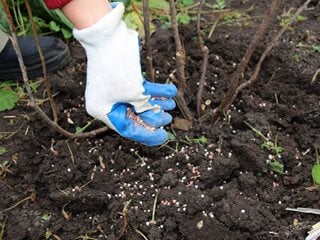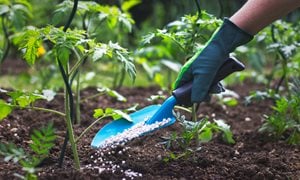GARDEN FERTILIZER 101
Compare types of fertilizers and learn when and how to feed your plants for a healthier gardenAnyone who has gardened knows that plants need nourishment in order to be healthy and thrive. In residential landscapes, Mother Nature needs a little help from gardeners to replace depleted nutrients. Since plants have different needs and there are many different types of fertilizers, knowing when and how to fertilize can be daunting. Here’s some basic information to help you better understand what type of fertilizer(s) your garden needs.
On this page: Types of Fertilizer | Nutrients Plants Need | When and How to Fertilize |Success Tips | Organic Amendments
On this page:
TYPES OF FERTILIZER
It’s important to determine what your plants need in order to choose the right fertilizer. Pre-packaged fertilizers are formulated to meet different nutritional needs, with some specifically formulated for roses, trees and shrubs, vegetables, lawns, or bulbs to remove the guesswork.
Organic vs. inorganic:
Fertilizers are available as organic (plant or animal derived) or inorganic (man-made from chemicals). Organic types are better for the environment and help to improve overall soil health. Inorganic fertilizers do nothing to improve soil and have no positive residual effect. In some cases, they can be harmful to the environment and wildlife, so it’s important to weigh the pros and cons before using.
Granular vs. water-soluble:
There are two basic forms of fertilizers, each with advantages and drawbacks. Slow release granular fertilizers have the advantage of delivering nutrients over a longer period of time. Water-soluble fertilizers are faster acting, delivering a boost of nutrients when plants need a quick pick-me-up. These are generally less harsh and not as long-lasting, so need to be applied more frequently.
Other popular fertilizer options include fertilizer spikes, liquid fertilizers, and compost teas.
NUTRIENTS PLANTS NEED
Horticulturist and owner of Variegata Studio, Denise Kelly, says, "It’s helpful to remember that fertilizers are more akin to vitamins than food, especially when deciphering application rate and frequency. Plants make their own food through photosynthesis, harnessing the energy of the sun to create sugars from carbon dioxide and water. Plants also require mineral elements (similar to our vitamin supplements) for essential life processes; fertilizers provide one or more of these essential elements. Nitrogen, Phosphorous and Potassium (N,P,K) are the three elements most likely to be deficient in our soils, as plants use them in greater amounts compared to other nutrients."
The three primary nutrients (macronutrients) that all plants need are nitrogen (N), phosphorus (P) and potassium (K).
Nitrogen promotes healthy leaf growth by stimulating the production of chlorophyll, which is the main pigment that allows plants to convert sunlight into food. Too much nitrogen will result in too much foliage and fewer flowers or fruit, while not enough nitrogen results in yellow leaves, stunted growth and smaller flowers or fruit.
Phosphorus promotes healthy stems and root development, along with abundant flower and fruit production. A shortage of phosphorus can result in leaf drop, weak flower stems and buds that won’t open.
Potassium, also referred to as potash, is an overall nutrient used by the entire plant. It helps plants utilize their photosynthate, and allows quicker recovery from insect and disease damage or weather extremes. Lack of potassium can result in yellow leaf margins, weak flower stems and poorly developed buds.
Nutrient ratios: The N-P-K ratio refers to the percentage of nitrogen, phosphorus and potassium that is in a fertilizer.
- If you want to boost flower production, a formulation such as 12-55-6 will contain a higher amount of phosphorus, which promotes more blooms.
- To green up your lawn, a fertilizer with a ratio such as 29-0-4 contains a higher concentration of nitrogen, which boosts lush foliar growth.
Other nutrients:
In order to thrive, plants also need micronutrients and trace minerals in smaller amounts, which include calcium, magnesium, sulfur, boron, copper, iron, manganese, and zinc.
WHEN AND HOW TO FERTILIZE
Most plants benefit from the application of a slow-acting granular fertilizer in early spring to jump-start new growth. Some plants such as natives and succulents need little to no supplemental fertilizing. Factors such as soil type, pH, moisture, drainage, and temperature can affect a plant’s ability to absorb nutrients. Here are some general guidelines; some plants within these categories may have different needs.

A gardener applies a slow release fertilizer around the base of a currant shrub. Photo by: photowind / Shutterstock.
Trees and shrubs:
Most trees and many shrubs need little or no supplemental fertilizer, depending on soil health. If necessary, apply a granular fertilizer in early spring. Use a fertilizer specially formulated for trees and shrubs and apply around the drip line.
Perennials:
Most ornamental perennials will thrive in healthy soil, needing little supplemental fertilizer. Mulch established plants with 1-2 inches of compost in early spring, or fertilize once in spring with an all-purpose granular fertilizer.
Roses:
Roses are heavy feeders, requiring regular nutrients throughout the growing season. Reapply fertilizer every 2-6 weeks from spring through summer, depending on the type of fertilizer used. Stop fertilizing 6-8 weeks before your first average frost date to avoid possible damage to new growth. Many modern hybrids can be fertilized less often. Learn more: How to Fertilize Roses.
Annuals:
Most annuals are heavy feeders, benefiting from an ongoing source of nutrients for continuous bloom throughout the summer. Amend beds with compost or use a high quality potting soil for containers. Apply an all-purpose granular fertilizer or liquid fertilizer such as fish emulsion every 2-6 weeks according to package instructions.
Vegetables:
Vegetable crops benefit from well-amended soil and adequate fertilizing to maximize production. Nutritional needs vary according to the type of crop grown.
Fruits:
Strawberries, blueberries, cane berries, and fruit trees all have different nutritional needs and fertilizing schedules, which can vary by region. Consult your local extension service or garden center for more information. Get tips on caring for strawberries.
Lawns:
As a general rule, apply a high-nitrogen fertilizer specially formulated for lawns in spring and again in fall. Some regions will vary. Leave freshly mowed grass clippings for an additional source of nitrogen.
Bulbs:
For spring-blooming bulbs, work in bone meal or bulb fertilizer into the planting hole according to instructions. For established beds, top dress with an all-purpose or bulb fertilizer in fall, and again in early spring when new growth appears. Summer bloomers such as lilies need little supplemental fertilizer as long as soil is healthy. If desired, work bulb fertilizer into the soil around plants in early spring.
Seedlings:
Wait until plants develop their first set of true leaves before fertilizing. Use a mild liquid fertilizer such as fish emulsion at half strength and apply twice a week, or at full strength every 7-10 days. If you are using potting soil that contains fertilizers, there’s no need for supplemental nutrients.
No matter what type of fertilizer you are using or what type of plant you are applying it to, it's very important to water thoroughly before and after to avoid burning roots and to deliver nutrients to the root zone more effectively.
SUCCESS TIPS
- It’s important to know your soil’s overall health before applying fertilizer, as too much fertilizer can be as damaging as not enough. Find more information on how to evaluate your soil.
- Brush granular fertilizer off leaves to prevent foliage burn.
- Group plants with similar light, soil, and nutritional needs together to make it easier to care for them.
- Because containers need more frequent watering, nutrients leach out quicker than for plants in the ground. Fertilize containers more often, every 2-4 weeks.
- Some fertilizers work better when temperatures are warmer, but avoid fertilizing during extreme heat spells to avoid stressing plants.
ORGANIC AMENDMENTS
Besides prepackaged fertilizers, there are individual amendments and soil enhancers. Here are those most commonly used:
Compost is one of the most essential soil amendments, improving soil structure and providing a wide spectrum of nutrients and minerals. It can be homemade or bought commercially, and includes mushroom compost and worm castings. Compost promotes overall plant health, increasing resilience to pests and diseases. Work into the soil at planting time, or apply a 1-2 inch layer each spring around the base of established plants. It can also be steeped in water and used as a tea. Compost can rob plants of nitrogen if not completely broken down, so it may be necessary to supplement with a nitrogen source. Learn how to make your own compost at home.
Manure consists of waste from livestock animals including cows, horses, chickens, steers, or rabbits. One of the best overall fertilizers, manure is packed with nitrogen and other nutrients, as well as trace minerals. It is both a fertilizer and amendment, improving soil structure and promoting lush growth. Make sure manure is well-aged so it doesn’t burn plants. Work into the soil at the time of planting or mulch established plants with a one-inch layer in spring. Manure can also be steeped in water and used as a tea.
Bone meal, a powder made from finely ground animal bones, is rich in phosphorus and calcium, which helps promote vigorous growth, root development and plentiful flowers. Apply in spring for a slow-release effect through the growing season and again in fall to promote root growth and next year’s flowers.
Cottonseed meal, a dry byproduct of cotton production, improves soil texture and boosts overall plant health. Apply once or twice a year for a slow-release effect throughout the growing season. Since it is somewhat acidic, soil pH may need to be adjusted with lime or other alkaline source.
Kelp meal or seaweed extract contains more than 70 vitamins, trace minerals, and amino acids essential to overall plant health. Available as a dried powder or liquid concentrate, kelp promotes root development, boosts immunity from pests and diseases, and stimulates beneficial soil bacteria. This can be part of a regular program throughout the growing season.
Fish emulsion, an excellent all-purpose fertilizer, promotes lush growth, improves soil texture and supports beneficial microbes. Most sources are liquid concentrate, but it can also come in pellet form. Apply every 2-4 weeks for a continuous food source that won’t burn plants. Fish fertilizer is often used in combination with kelp.
Alfalfa, which is often grown as a cover crop, is also available in granular or pellet form. One of the best overall organic amendments, alfalfa improves soil texture and is rich in macronutrients, micronutrients, and trace minerals. It contains triacontanol, a natural growth stimulant.
NEW TO GARDENING?
If you're not sure where to start, the Garden Design editors recommend The New Gardener's Handbook: Everything You Need to Know to Grow a Beautiful and Bountiful Garden, by Daryl Beyers, an expert from the New York Botanical Garden. You'll find easy-to-follow information on:
- Soil
- Planting
- Watering
- Pruning
- Fertilizing
- & more!



